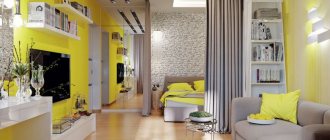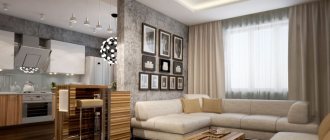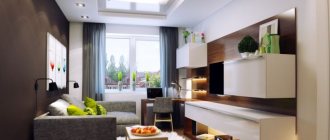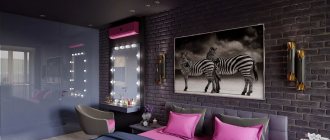The Russian language is rich in lexical units that cause difficulty in writing due to the appropriate several options for the written rendering of the word, or sounds that are not displayed in writing when consonants are abbreviated, etc.
As a rule, it is ignorance of how to act in a given situation that leads to the manifestation of all one’s illiteracy. It is not always possible to replace a word with the corresponding synonym to simplify the task for yourself. What to do then? For example, it is very difficult to find a check for the lexeme in the middle, how is it written: together or separately? Can both options coexist?
General rules for zoning space
To properly divide the space, you need to take into account both the wishes of the owners, who should feel comfortable in their home, and the design rules. This will allow you to create a suitable design in your apartment or house.
Relevance for the chosen interior style
A room divided into zones remains a single space. Therefore, a combination of different areas is needed. For example, decorating a work area (office) in a minimalist style is inappropriate if the interior of a bedroom or living room is designed in classicism.
The designer’s task is to maintain two zones in the same style, and not to separate them.
To visually perceive 2 functional zones as different spaces, zoning can be done using a color scheme. For example, avoid duplicating the color of the kitchen with the shade of a soft corner or chest of drawers. However, the tones must be in harmony with each other. Thus, dark tiles in the kitchen and light laminate in the hallway require similar colors for furniture and other accessories, incl. paintings, pots for indoor plants, etc.
Taking into account the area and shape of the room
Corner apartments with several window openings are well suited for zoning space. However, even a small studio with proper arrangement of furniture and installation of partitions will become a comfortable place to live.
If the room is elongated in shape and resembles a rectangle, it is not recommended to divide it into zones along the walls, leaving a narrow passage in the middle. Otherwise, the home will resemble offices in government agencies. In the design of a rectangular room, a shelving unit in the middle or a podium looks good.
Availability of free space
To avoid the room resembling an office, it is better to leave a distance of at least 70 cm for passage between the arranged furniture and the zones themselves. Moreover, if the apartment has hinged wardrobes, the indicator should be increased.
When zoning studios, designers prefer minimalist built-in furniture.
Emphasizing the center of the room
Emphasizing the center of the room is applicable regardless of the room and is suitable for the design of each designated area. For example, you can use decorative furniture, shelves, carpets, etc. A good way is to place a table with a glass surface in an area intended for relaxation.
Light source
Often, when a small apartment is zoned and there are no panoramic windows, the room becomes dark and uncomfortable. To avoid discomfort, additional light sources are used: built-in LEDs, sconces, table lamps, etc.
Compact storage
After zoning, the space is either thought out in such a way that there is no free space for other ideas, or it often turns out to be overloaded with furniture and decor. Therefore, for storing things it is better to provide cabinets, mezzanines, chests of drawers, etc., so as not to violate the integrity of the interior with hangers and shelves.
Example sentences
- Since almost all the seats were taken, I sat in the middle.
- When planning a future construction project, I decided to build a small gazebo right in the middle of the site.
- Today at art school I remembered one important rule for drawing a person's face: the eyes are positioned so that you can draw them after drawing a line in the middle of the face.
- That same dry area in the middle of the lake was again overgrown with various herbs.
Similar article “Precedent” or “precedent”: how to spell the word?
Methods for zoning space
Each method aimed at zoning space has its own advantages and disadvantages.
You can look at examples of space zoning in various ways in the photo.
Walls, arches
You can zone the space with partitions. For example, to separate an area without voids near the ceiling, it is recommended to install a thin plasterboard wall.
You can make an arched opening, separating part of the room from the main space. Installing a full wall in a small apartment is undesirable, since the limited area will become even smaller by several square meters.
Such methods will allow you to create a work area, a children's room or a relaxation area, isolated from the rest of the area. However, partitions and arches will not protect against extraneous sounds, which is worth considering if you need silence and privacy.
Separation by partitions and screens
Screens and partitions made of plasterboard, wood, glass, fabric and other materials are considered an effective method of zoning space. This method, unlike the construction of massive walls, does not require approvals and allows you to divide the apartment into functional parts depending on their purpose.
Stationary
Mounted in the middle or on one side of the room. Solid structures from floor to ceiling visually make the room smaller, so they are not recommended for small apartments. In such cases, when installing partitions, it is better to leave a distance, i.e. make them half the height of the room or equip them with through shelves and arrange a rack.
Glass or mirror partitions will help separate the desired corner and visually expand the area.
Sliding
Partitions act as walls and doors. The structures include a single panel (or several), the movement of which occurs along guides - rails. Sliding walls and partitions in an apartment are considered a good way to design wide openings and zone studios, for example, to divide a living room with a kitchen. They are appropriate in large rooms because they look massive in a small area.
Folding
The mechanism is designed in such a way that when opened, the door leaf gathers into small leaves. In terms of design, the system resembles an “accordion” or a “book”, and the first option is more practical. Folding partitions save space and are recommended for zoning small spaces.
Mobile
These are screens that are not attached to the ceiling, floor or wall. Mobile partitions are quick to install and disassemble and can be moved to another location.
The designs are:
- flexible (these are canvases that can be bent);
- 1-screen (consist of a wide panel, the mechanism is often equipped with rollers);
- casement (include identical sections folded like an accordion).
Thick textiles are used for the screen material, which eliminates unevenness and folds on the surface. Mobile partitions will add coziness to the interior and, if properly designed, will become a unique art object.
Furniture zoning
Furniture arrangement is considered the most functional and mobile method of dividing space. However, designers recommend leaving enough free space around massive objects (cabinets, soft corners, etc.), which will avoid the feeling of discomfort and cramped space.
"Attention! For large apartments, you can choose massive sets equipped with a convenient storage system (shelves, niches, etc.). For rooms with small square footage, transformable furniture is preferable.
Cabinets and shelving
The correct arrangement of cabinets and shelving allows you to divide the room. For example, if you place the set across the room close to the wall, you can separate a work area in the nursery or a bedroom in the living room. Designers advise choosing small cabinets, since massive and tall ones become a barrier to sunlight, making the room look uncomfortable.
Dividing a common room is possible by correct placement of furniture, which should not block the passage from one improvised corner to another. In small apartments, it is better to use shelving rather than massive sofas or armchairs. They zone the room and act as a place to store things. A shelving height of 1.2-1.5 m is sufficient for visual perception of space.
"Attention! Don't use shelving just to store books. You can place various souvenirs, vases and pots with indoor plants on the shelves, which will add sophistication to the interior and improve the visual perception of the room design.”
Sofas and armchairs
To create a comfortable area for a family conversation or meeting with friends, 2 chairs located opposite each other are suitable. If you place a single copy, and next to it there is a small table and a floor lamp, you can organize a full-fledged work area for needlework, reading books, etc.
Placing a sofa will help divide the room into a dining room and living room or differentiate a bedroom from a common area. In a spacious apartment, corner modular sets are recommended.
It is better to place the sofa with its back to the bar counter, kitchen or other area.
Chest of drawers or nightstand
The creation of two zones is possible thanks to drawers for storing things, which, in combination with the small size of a chest of drawers or cabinets, is appropriate for small rooms. In open-plan rooms, such furniture will clearly mark the boundaries of the hallway or living room. To enhance the zoning effect, the chest of drawers is often placed along the back of the sofa.
Designers advise placing accessories or flowerpots with indoor plants of the same height on the tabletop of the cabinet, which will further emphasize the boundaries of different rooms.
Zoning using finishing
To divide a room into zones, you can use different methods of finishing the floor, walls and ceiling.
Walls
Zoning on the wall using different finishing materials is a favorite technique of designers. In this way you can create a truly stylish interior.
Several options for modern combinations:
- One part of the wall is finished with slats painted in the color of the wall or left in natural color - the rest remains simply painted
- Soft wall coverings in the bedroom area, Venetian plaster finishing in the living room area
- Using moldings in the living room area
- Highlighting an accent area with panels - mirror, marble, wood, 3D
Flooring
Finishing the floor with different materials will help divide the room into functional zones. They will differ in texture, color, patterns, etc. Often this scheme is used to delimit the kitchen and dining area, hallway and living room.
When making repairs, make sure that there is no difference in height - the floor must be level even when using different materials. It is important to think about the junction location in advance.
It is better not to build podiums of 10-15 cm for several reasons: an outdated design element, the use of a robot vacuum cleaner will be complicated by unnecessary actions.
Ceiling
You can delimit the space with ceiling coverings of various tones and patterns. For example, in passage areas the ceiling will be 10 cm lower than in the central part of the room. On flat surfaces, the method of shadow seams is often used to mark the boundaries of rooms.
Combinations of different coatings on the ceiling also look interesting.
Zoning with decorative elements
You can divide the room into 2 parts with decorative elements: columns, beams. When designed correctly, this approach will create the appearance of rooms with different purposes and decorate them.
Columns
They are considered a good alternative to doors and an aesthetic method for dividing a room. Thanks to the ability to adjust the shape, size and place various decorative elements on the surface. They fit well into the loft and art deco style. And inside you can hide electrical wires, provide sockets, or illuminate the surface, which looks beautiful at night.
"Attention! Columns are preferable in spacious rooms with high ceilings. In small rooms, for example, with an area of 16 square meters, designers advise using fluted pilasters, which help to visually increase the area.”
Rack zoning
Decorative beams will help delimit the apartment and bring an atmosphere of authenticity to the interior.
It is better to install them vertically - dust will not settle horizontally on the surface
Lighting, palette and texture
You can divide a room into zones using light, texture and color.
Light
Light can create visual effects, which gives the room a cozy feel and allows you to highlight areas for relaxation, work, etc. This technique eliminates the use of similar chandeliers or lamps in different parts of the room. For each zone, if the space is spacious, there should be its own main source of lighting, but it is better to make the background light common to the entire room.
Proper lighting will help create a zoning effect and highlight different parts. For example, in the center of the hall you can hang a bright chandelier, and in the reading corner - a floor lamp emitting diffused light. To delimit space, hidden lighting of different tones is suitable, since it is easier to highlight one wall with directional light.
Color
An important rule: similar colors contribute to the visual unification of zones, and contrasting ones help to separate them. For example, in a children's room intended for both a boy and a girl, you can differentiate the room by painting the walls blue and pink. Light colors in the living room will help separate the common space from the workplace, where the surfaces are dark.
"Attention! The colors should be combined with each other and create the integrity of the composition. Therefore, you need to understand the rules for combining colors with each other.”
Zoning with different tones or contrasting colors is a quick and inexpensive way to delimit space. Designers advise highlighting areas near windows with dark shades. It is better to decorate areas located near solid walls with light colors.
Texture
Texture makes the interior interesting and spectacular. Designers advise using decoration and paraphernalia from different materials. For example, in the living room or dining area it is better to prefer smooth and reflective surfaces, and in the bedroom or children's room - fluffy, soft ones (screens, pillows, fabric).
Original zoning methods
You can divide a room into two using original ideas. For example, a carpet, curtains, pieces of art, etc. give a good zoning effect.
Carpet
A soft carpet in the interior creates a feeling of warmth and comfort. You can lay a carpet in one of the areas - in the bedroom area at the foot of the room or in the living room near the sofa. For a modern interior, it is better to choose lint-free rugs.
Curtains
They promote free circulation of air and light in space, creating individuality and comfort in the interior. Thick curtains are often used to disguise the sleeping area in the living room, but they visually make the room smaller. Therefore, it is better to use a transparent canopy or hang curtains during the day.
Depending on the style of the room, blinds, beads, muslin, etc. can be used instead of fabric.
Curtains and tulle may seem like an inexpensive way of zoning, but high-quality fabric costs a lot. They are also very difficult to fit into the interior correctly - to make the room more stylish and cozy you will have to work hard. Therefore, if you are not a professional designer, we recommend using a different material for zoning.
Art objects
Works of painting not only attract attention, but also indicate the boundaries of the areas, since the purpose of the zone can be emphasized by hanging paintings with different subjects and palettes.
Black and white large paintings or a set of posters look modern. Posters will look good if you hang them around the perimeter of a geometric figure. “Interior painting” looks good with abstraction.
Bushy indoor plants
An eco-friendly method for zoning a room is a wall of plants. It goes with almost any style. Can be used:
- flowerpots with tall flowers;
- compositions from hanging flower pots;
- racks with climbing plants.
Mini hedges in pots look good.
You can also use pots with plants in only one area, for example on a wall. This will visually separate the area from the general space.
Aquarium
A good method that additionally indicates the boundaries of rooms is an aquarium placed in a partition or on a shelf. Thanks to the lighting, such an element creates a relaxing environment, and glass and water do not interfere with the penetration of light. The aquarium will decorate any interior.
Home cinema
You can zone the space with a home theater placed on a cabinet or in a false wall. An alternative is a roll-up projector screen.
The most effective methods of zoning
There are various options for zoning a room. However, according to reviews from apartment owners, screens, shelving, sofas and podiums are considered the best ways to delimit space.
Screens
Screens can quickly close the bedroom from the views of visitors. Various design options are available: wood, fabric with a print on a metal frame, plastic translucent sheets, mirror sections, etc. It is important to choose a stylish screen that matches the style of the interior, otherwise the room will become absolutely tasteless.
The decorative screen looks good.
Rack on casters
The recommended height is no more than 1.5 m. Rollers allow you to quickly move the rack. For example, before guests arrive, you can separate the sleeping area or another corner that is not intended for prying eyes.
Roller sofa
Like a roller rack, it allows you to temporarily delimit space. Or you can use the sofa both as a sleeping place and in the living room, unfolding it depending on the time of day.
Folding podium
The podium is often used in the loft style and saves space. Pull-out beds, drawers and boxes allow you to increase the living room area. Pallets at the head serve as a partition and can be folded.
Effective ways
Podiums and tiers
The method is suitable if the apartment has high ceilings, otherwise the second level will not look good. For example, you can make a children's corner, i.e. place a sleeping place on the 2nd tier, and arrange a play area on the first tier, place a table, etc. However, it is worth calculating the height, since when getting out of bed in the morning, the child should not touch the ceiling in a sitting position.
A suitable way to divide the space is a low podium (0.8-1 m) with steps. You can lay a carpet on it, put a soft sofa with armchairs and a small table, creating a corner for relaxation. The space under the podium is suitable for storing things.
To highlight a separate area, you can raise the floor to a height of 0.3 m. This will delimit the room and create additional storage space below. A bedroom is often located on the podium, and there is a TV on the wall. The rest of the room is allocated to the living room.
Glass
Glass partitions to delimit a room are welcomed by many designers. This material does not limit daylight, which visually increases the area. Such partitions are safe because thickened tempered glass is used in production.
For zoning you can use the following structures:
- equipped with solid glass sections;
- frame - made of aluminum, steel or wood, which strengthen the partition;
- prefabricated, which consist of hollow glass blocks in the shape of a square or rectangle (characterized by increased heat and sound insulation).
To add sophistication to the room, you can use radius partitions that eliminate sharp corners. They are made from bent glass.
Available options for placing a sofa in the center of the room
There are several ways to place a sofa across the room; most often, it is used to simply separate part of the guest area from another room. In this case, it is placed facing the entrance of the living room. If you need to divide one large area into two rooms, for example, a bedroom and a place for family recreation, in this case this furniture option will also come to the rescue.
Such furniture can be placed exactly in the center or leaned against one of the walls with one side. Sometimes you want to make one part of the living room more closed, this can be achieved with the help of a second small sofa, armchairs or daybed, which are placed at right angles to the central piece. If the interior is decorated in a classic style, in this case you will have to observe the basic principles of symmetry.
To comply with the rules of the classics, you need to create a special center of composition in the room, that is, a kind of symmetrical axis, according to which objects will be arranged. The central part can be a TV or fireplace, a mirror or a large picture on the wall. The arrangement of sofas depends on the size of the room; if it is spacious, they need to be moved to the center; in small living spaces it is better to place such furniture near walls opposite to each other.
In large living rooms, options that are similar in style and decor look great, while one of them can be corner and the other standard. If you place one such sofa in the center of the room and place another nearby, you will get a separate comfortable area, ideal for sleeping and relaxing. These pieces of furniture should be quite compact and not take up too much space.
<
>
How to choose a partition material
The choice of material for partitions depends on the wishes of the owners, style, etc. For example, in eco-style, plastic, various synthetics, etc. are excluded. Natural materials are suitable here: natural stone, wood, bamboo. You can use live plants for partitions.
Wooden structures fit into the interior regardless of the style of the apartment: classic, minimalism, hi-tech, etc. In the production of partitions, different wood is used, incl. pine, ash, beech, oak. Popular designs are made from chipboard, MDF, and chipboard. It is better to use solid wood when decorating spacious rooms, because, for example, a partition made of timber will reduce the area and will look massive, which is undesirable in a limited space.
Stone walls are more suitable for interiors decorated in a castle style. They are often used to delimit zones in baroque, minimalism, loft, and high-tech. Stationary partitions are based on brick, plaster, concrete, and gas silicate. Wallpaper, ceramic tiles, paint, clinker and other materials are suitable for surface finishing. Stone partitions in the loft style are appropriate without additional decoration.
To zone a room, you can choose fabrics and equip partitions in the form of:
- screen;
- classic curtains;
- Japanese curtains with a horizontal bar as a plumb line;
- ribbons with rings, beads made of wood or glass;
- Japanese-style curtains with a horizontal bar at the bottom for weighting.
Fabric sheets are mounted on a cornice or on a rigid frame.
A good way is to use plexiglass interior partitions. This is acrylic plexiglass. The material is easy to install, durable, lightweight and allows you to implement various design ideas.
Openwork partitions are created from plexiglass:
- embossed;
- with patterns;
- glossy;
- transparent;
- matte;
- mirror, etc.
Interesting panels for partitions are made of decoacrylic. This is a material with built-in decorative elements: LEDs, sparkles, stones, etc.
"Idea! Partitions made of chipboard are often used for zoning. Thanks to the flexibility of the sheets, you can create curved walls that look beautiful, especially with climbing plants. For similar purposes, with appropriate processing (moderate wetting), drywall is also used.”
Photos of different partitions
In the photo you can see examples of different partitions that delimit the area in small apartments.
Interior of a room with a sofa. Model selection
Of course, the most luxurious sofa option is the corner one. It will fit perfectly into any environment. But it is more often suitable only for spacious rooms. After all, the overall dimensions of such models are very large. There is no doubt that this sofa has many useful features. For example, it perfectly smooths out corners in a room. Often, models of such sofas are equipped with various folding tables, shelves for books or various small decorative items, and even minibars. Of course, this is one of the most convenient models for large families.
Features of zoning different rooms
When delimiting space, designers take into account the purpose and functionality of each zone. What is appropriate for one room may not be appropriate for another.
Bedroom and office
You can separate an office in the sleeping area using a shelving unit. It will become not only an element that delimits space, but also a place to place documentation, office supplies, a telephone, etc.
You can separate the office and the bedroom by making sliding doors, wooden or glass doors.
Floor coverings are considered a popular way to delimit zones. For example, laminate is appropriate in the office, and carpet in the bedroom. Or you can use linoleum of different shades. An additional element indicating the sleeping area will be a soft fluffy carpet.
The separation of colors looks beautiful: the office is in light colors, and the bedroom is several shades darker. You can create a workplace where the bedside table is standardly located.
"Attention! It is better to choose a place for the office closer to the window, which promotes high-quality daylight. You can create a work area on an insulated balcony or design a table instead of a window sill.”
Children's and playroom
In the children's bedroom it is necessary to allocate space for relaxation, activities and a play area. A good way would be a 2-tier design, where there is a bed on top and a desk below. Transformable furniture is often used in limited spaces. For example, a table that folds up and seems to merge with the wall, allowing the child to play in the free space.
A good way to delimit space would be a carpet, since you can use it to separate the play area and place a sofa bed next to it.
Living room and bedroom
To organize the living room and bedroom in one room, different furniture is used. For example, a good way is a sofa on rollers, which will become a place to relax and chat with friends. You can delimit the space by making multi-level ceilings, podiums, and bar counters.
Popular methods include low partitions, curtains, translucent shelving, etc. You can place a bed and a sofa in the same room by placing the first in a niche and surrounding it with translucent curtains or a canopy.
"Attention! It is better to place the bedroom in the corner of the room so that the bed does not create obstacles when moving around the apartment. For the living room, you need to choose an area with maximum natural light.”
Zoning the kitchen from the dining room or living room
To differentiate the kitchen from the dining room, a good solution would be zoning with a bar counter.
The best solution for zoning the living room and kitchen is zoning by finishing the walls, ceiling and floor.
An interesting solution would be to imitate a patchwork tile carpet under the dining table.
Bathroom and toilet
Often a combined bathroom is a room 2 by 2 m. To separate the bathroom and toilet, you can use a screen or partition. However, color effects can be used to visually divide the space. For example, paint the walls in different colors: blue near the bathtub, white near the toilet. However, it is worth considering the contrast of tones, because... sharp changes in color will be inappropriate.
Combining a balcony or loggia with a room
It is necessary to make a continuation of the room from the loggia on legal grounds; the demolition of load-bearing walls is fraught with the destruction of the house. Removing the doors to the loggia and dismantling the window without destroying the reinforced concrete is not considered redevelopment.
It is necessary to insulate the balcony area. A warm floor is considered the ideal option; additional heating radiators are less often installed under the windows of the loggia.
In the loggia area they often make a mini-bedroom, an office or a chill-out area.
Why put a sofa in the middle of the room?
Not all owners of residential premises know exactly how and why to place a sofa in the middle of the room and often make serious mistakes. It’s always easier to place it near the wall, which is what most people do, but modern interior design requirements dictate their own rules. Many studio apartments are equipped with large spaces that can be divided into comfortable parts, in which case a sofa of any size will be a real find.
This zoning method is often mistakenly used only for spacious living rooms. In fact, with the help of a sofa, it is quite possible to divide a too narrow space into two zones, one of which will be intended for work, and the other for relaxation. And this is just one of many examples. In addition to the excellent opportunity to balance the space, room owners can give free rein to their imagination, come up with a new design and equip themselves with the most comfortable work area.
<
>
How to zone a one-room apartment for a family with children
An effective way to emphasize the zoning of a one-room apartment is to use a sofa bed. The latter must be placed perpendicular to the wall. Facing the living room, the sofa provides a comfortable seating area. At the back, behind the backrest, you can place a baby cot, which will be hidden from prying eyes. It is recommended to organize a play area near the window so that the child can feel light and warm thanks to the sun's rays and a heating radiator.
This division into children's and adult areas allows for rational use of limited space. The advantage is a minimum of furniture, and it looks beautiful. On 18-20 sq m you can place 3 functional areas: a living room, which becomes a bedroom at night, and a children's room with a play area.
Suitable Models
Absolutely not all sofa options are suitable for central division. When choosing this piece of furniture in a store, you need to select only the most optimal options in terms of size and type of folding. Ordinary books take up a lot of space; it is better to replace them with models with a roll-out mechanism, which are perfect for comfortable sleeping at night and relaxing during the day.
The comfortable sofa unfolds very simply; to do this, you need to pull out its lower part and place a soft seat on top. This model is perfect for small living rooms where it is necessary to save additional free space. For those who are not bothered by the lack of drawers for linen in the middle of the sofas, so to speak, “dolphins” are perfect. They are divided into 2 halves, one of which is pulled forward using a loop.
American and French folding beds also do not cause problems and are distinguished by their miniature sizes. These living room models are equipped with frames made of metal and, when assembled, take up little space. When choosing the right models, in most cases, attention is paid to their style and design, upholstery color and folding mechanism. The right furniture of this type should fit perfectly into the interior and be combined with other items. If all the rules of separation are implemented, any model can be correctly placed in the very center of the room.
How to buy the right sofa?
Owner of the living room - Sofa
Dividing a house without internal walls into zones
You can delimit space in a house without internal walls by building a suitcase podium. This design folds in half, which is convenient if a mattress is used as a bed. Before guests arrive, the sleeping place is removed inside the podium, turning the podium into a comfortable table.
Plants will help divide the space in studio apartments. For example, it is enough to place several flowerpots with tall flowers to delimit the area of the kitchen and dining area. Nearby you can place a sofa with its back turned, which will mark the boundary of the bedroom.
Example sentences
- Our coach was an experienced kayaking expert. That is why he recommended passing this section of the river along the middle, since the water level is low and there is a possibility of hitting stones.
- The teacher monitors us all the time so that we plant all the flowers only in the middle of the alley.
- Despite all the traffic rules, the driver ignored the markings and drove this section in the middle of the dividing strip, which is a gross violation.
- Overtaking is prohibited here, and this is evidenced by the double dividing strip, which is clearly visible in the middle of the road.
Photo examples of studio zoning
In the photo you can see examples of dividing a studio apartment into different functional areas.
Modern Sofa Styles
1. Provence - suggests laconic upholstery with floral prints, stripes or checks. Monochromatic natural colors bring contrast to the interior.
2. Classic - furniture should be voluminous and have smooth outlines. Jacquard, tapestry and velor are used as upholstery.
3. Minimalism - this style is characterized by clarity of shapes and lines, and the absence of ornamentation on the upholstery.
4. Modern classics - distinguished by carved armrests, expensive upholstery and large dimensions.
5. Country - combine floral motifs and delicate colors.
6. Modern - most often sofas are black or white with chrome legs and armrests.
Common mistakes when zoning a room
Common mistakes when zoning space are:
Massive furniture located in the center of the room
It not only prevents the penetration of sunlight, but also visually reduces the area. If it is impossible to remove a cabinet or bulky rack, it is recommended to decorate the walls with an identical color or use mirror panels
Poor lighting
Each zone must contain its own light source. For example, with a single chandelier, any zoning, especially in the evening, will become meaningless
Too much contrast
You need to choose the right color for the floor, walls, textiles, etc. If the tones do not match each other, look bright and provocative, the apartment will look like a souvenir shop or exhibition. The same applies to contrasting wallpapers, which are often used to divide space, although on their own they poorly distinguish individual zones
Imitation of partitions in an apartment for two adults (or more)
It is worth considering that isolating yourself from other family members is often inappropriate, since this approach affects the interior. For example, translucent tulle is suitable for separating a bedroom rather than a working area
A common mistake is to rely only on the arrangement of furniture when zoning a room. It is worth considering that delimiting space requires a set of measures. Therefore, it is better to entrust the work to designers before the planned renovation, which will allow you to select materials, colors, partitions, light sources, etc.
Which rooms are suitable for separation?
It is important to remember that you can install a sofa inside almost every room. With the right approach and following all the rules, the interior will turn out beautiful, even if we are talking about a small living space. You can entrust the design development to professionals or create everything yourself, showing creativity and imagination. It is best to develop a floor plan on a piece of paper or in a specialized program in order to see in advance how it will look in the end.
There are cases when installing a sofa exactly in the center is considered the only inexpensive option. It is important for rooms with a large number of windows and door openings; such furniture can be placed exactly in the middle or moved slightly towards the window, leaving a wide space behind. In very narrow rooms, reminiscent of large corridors, it helps to visually make them wider and divide them into two zones where other additional details can be placed.











